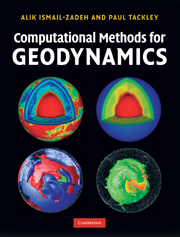Book contents
- Frontmatter
- Contents
- Foreword by Gerald Schubert
- Preface
- Acknowledgements
- 1 Basic concepts of computational geodynamics
- 2 Finite difference method
- 3 Finite volume method
- 4 Finite element method
- 5 Spectral methods
- 6 Numerical methods for solving linear algebraic equations
- 7 Numerical methods for solving ordinary and partial differential equations
- 8 Data assimilation methods
- 9 Parallel computing
- 10 Modelling of geodynamic problems
- Appendix A Definitions and relations from vector and matrix algebra
- Appendix B Spherical coordinates
- Appendix C Freely available geodynamic modelling codes
- References
- Author index
- Subject index
- Plates section
1 - Basic concepts of computational geodynamics
Published online by Cambridge University Press: 05 June 2012
- Frontmatter
- Contents
- Foreword by Gerald Schubert
- Preface
- Acknowledgements
- 1 Basic concepts of computational geodynamics
- 2 Finite difference method
- 3 Finite volume method
- 4 Finite element method
- 5 Spectral methods
- 6 Numerical methods for solving linear algebraic equations
- 7 Numerical methods for solving ordinary and partial differential equations
- 8 Data assimilation methods
- 9 Parallel computing
- 10 Modelling of geodynamic problems
- Appendix A Definitions and relations from vector and matrix algebra
- Appendix B Spherical coordinates
- Appendix C Freely available geodynamic modelling codes
- References
- Author index
- Subject index
- Plates section
Summary
Introduction to scientific computing and computational geodynamics
Present life without computers is almost impossible: industry and agriculture, government and media, transportation and insurance are major users of computational power. The earliest and still principal users of computers are researchers who solve problems in science and engineering or more specifically, who obtain solutions of mathematical models that represent some physical situation. The methods, tools and theories required to obtain such solutions are together called scientific computing, and the use of these methods, tools and theories to resolve scientific problems is referred to as computational science. A majority of these methods, tools, and theories were developed in mathematics well before the advent of computers. This set of mathematical theories and methods is an essential part of numerical mathematics and constitutes a major part of scientific computing. The development of computers signalled a new era in the approach to the solution of scientific problems. Many of the numerical methods initially developed for the purpose of hand calculation had to be revised; new techniques for solving scientific problems using electronic computers were intensively developed. Programming languages, operating systems, management of large quantities of data, correctness of numerical codes and many other considerations relevant to the efficient and accurate solution of the problems using a large computer system became subjects of the new discipline of computer science, on which scientific computing now depends heavily.
- Type
- Chapter
- Information
- Computational Methods for Geodynamics , pp. 1 - 23Publisher: Cambridge University PressPrint publication year: 2010



